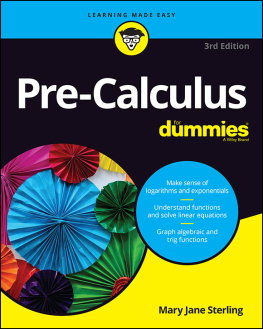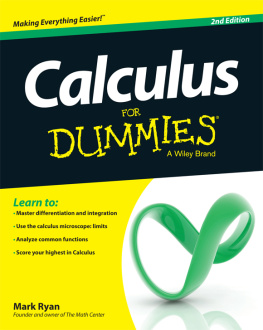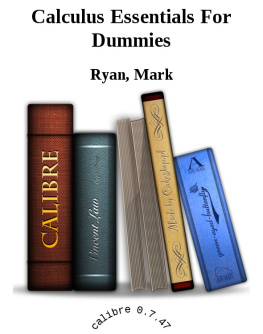Chapter 1: Functions, Limits, and Continuity
Equations and Graphs
Learning Objectives
A student will be able to:
- Find solutions of graphs of equations.
- Find key properties of graphs of equations including intercepts and symmetry.
- Find points of intersections of two equations.
- Interpret graphs as models.
Introduction
In this lesson we will review what you have learned in previous classes about mathematical equations of relationships and corresponding graphical representations and how these enable us to address a range of mathematical applications. We will review key properties of mathematical relationships that will allow us to solve a variety of problems. We will examine examples of how equations and graphs can be used to model real-life situations.
Lets begin our discussion with some examples of algebraic equations:
Example 1: The equation has ordered pairs of numbers as solutions. Recall that a particular pair of numbers is a solution if direct substitution of the and values into the original equation yields a true equation statement. In this example, several solutions can be seen in the following table:
We can graphically represent the relationships in a rectangular coordinate system, taking the as the horizontal axis and the as the vertical axis. Once we plot the individual solutions, we can draw the curve through the points to get a sketch of the graph of the relationship:
We call this shape a parabola and every quadratic function, has a parabola-shaped graph. Lets recall how we analytically find the key points on the parabola. The vertex will be the lowest point, . In general, the vertex is located at the point . We then can identify points crossing the and axes. These are called the intercepts of the equation. The intercept is found by setting in the equation, and then solving for as follows:
The intercept is located at
The intercept is found by setting in the equation, and solving for as follows:
Using the quadratic formula, we find that . The intercepts are located at and .
Finally, recall that we defined the symmetry of a graph. We noted examples of vertical and horizontal line symmetry as well as symmetry about particular points. For the current example, we note that the graph has symmetry in the vertical line The graph with all of its key characteristics is summarized below:
Lets look at a couple of more examples.
Example 2:
Here are some other examples of equations with their corresponding graphs:
Example 3:
We recall the first equation as linear so that its graph is a straight line. Can you determine the intercepts?
Solution:
intercept at and intercept at
Example 4:
We recall from pre-calculus that the second equation is that of a circle with center and radius Can you show analytically that the radius is
Solution:
Find the four intercepts, by setting and solving for , and then setting and solving for .
Example 5:
The third equation is an example of a polynomial relationship. Can you find the intercepts analytically?
Solution:
We can find the intercepts analytically by setting and solving for So, we have
So the intercepts are located at and Note that is also the intercept. The intercepts can be found by setting . So, we have
Sometimes we wish to look at pairs of equations and examine where they have common solutions. Consider the linear and quadratic graphs of the previous examples. We can sketch them on the same axes:
We can see that the graphs intersect at two points. It turns out that we can solve the problem of finding the points of intersections analytically and also by using our graphing calculator. Lets review each method.
Analytical Solution
Since the points of intersection are on each graph, we can use substitution, setting the general coordinates equal to each other, and solving for
We substitute each value of into one of the original equations and find the points of intersections at and
Graphing Calculator Solution
Once we have entered the relationships on the Y= menu, we press 2nd[CALC] and choose #5 Intersection from the menu. We then are prompted with a cursor by the calculator to indicate which two graphs we want to work with. Respond to the next prompt by pressing the left or right arrows to move the cursor near one of the points of intersection and press [ENTER]. Repeat these steps to find the location of the second point.
We can use equations and graphs to model real-life situations. Consider the following problem.
Example 6: Linear Modeling
The cost to ride the commuter train in Chicago is . Commuters have the option of buying a monthly coupon book costing that allows them to ride the train for on each trip. Is this a good deal for someone who commutes every day to and from work on the train?
Solution:
We can represent the cost of the two situations, using the linear equations and the graphs as follows:
As before, we can find the point of intersection of the lines, or in this case, the break-even value in terms of days, by solving the equation:
So, even though it costs more to begin with, after days the cost of the coupon book pays off and from that point on, the cost is less than for those riders who did not purchase the coupon book.
Example 7: Non-Linear Modeling
The cost of disability benefits in the Social Security program for the years 2000 - 2005 can be modeled as a quadratic function. The formula
indicates the number of people , in millions, receiving Disability Benefits years after 2000. In what year did the greatest number of people receive benefits? How many people received benefits in that year?
Solution:
We can represent the graph of the relationship using our graphing calculator.
The vertex is the maximum point on the graph and is located at Hence in year 2002 a total of people received benefits.
Lesson Summary
- Reviewed graphs of equations
- Reviewed how to find the intercepts of a graph of an equation and to find symmetry in the graph
- Reviewed how relationships can be used as models of real-life phenomena
- Reviewed how to solve problems that involve graphs and relationships
Review Questions
In each of problems 1 - 4, find a pair of solutions of the equation, the intercepts of the graph, and determine if the graph has symmetry.
- Once a car is driven off of the dealership lot, it loses a significant amount of its resale value. The graph below shows the depreciated value of a BMW versus that of a Chevy after years. Which of the following statements is the best conclusion about the data?
- You should buy a BMW because they are better cars.
- BMWs appear to retain their value better than Chevys.
- The value of each car will eventually be .
- Which of the following graphs is a more realistic representation of the depreciation of cars.
- A rectangular swimming pool has length that is greater than its width.
- Give the area enclosed by the pool as a function of its width.
- Find the dimensions of the pool if it encloses an area of .
- Suppose you purchased a car in 2004 for You have just found out that the current year 2008 value of your car is Assuming that the rate of depreciation of the car is constant, find a formula that shows changing value of the car from 2004 to 2008.










